|
 Dwight Peck's personal website Dwight Peck's personal website
Castles
in Switzerland
The
Château de Gruyères, 2003
  
Gruyères,
a fine old village-with-castle perched on a little hill in central-western Switzerland
-- way too many tourists, sometimes, especially in summer, but they're the reason
we've still got anything left at all, so let's keep welcoming them along and wait
till October for our own visit.
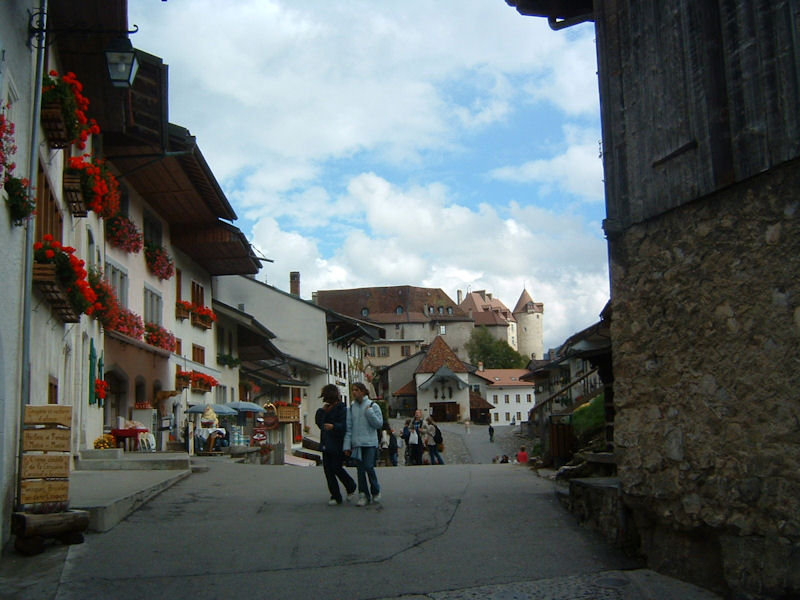
And here,
indeed, we find ourselves, in October 2003, just us (Satoki, Alison, and Dwight)
and an enormous crowd of schoolchildren out on the schoolbus for a Treat.
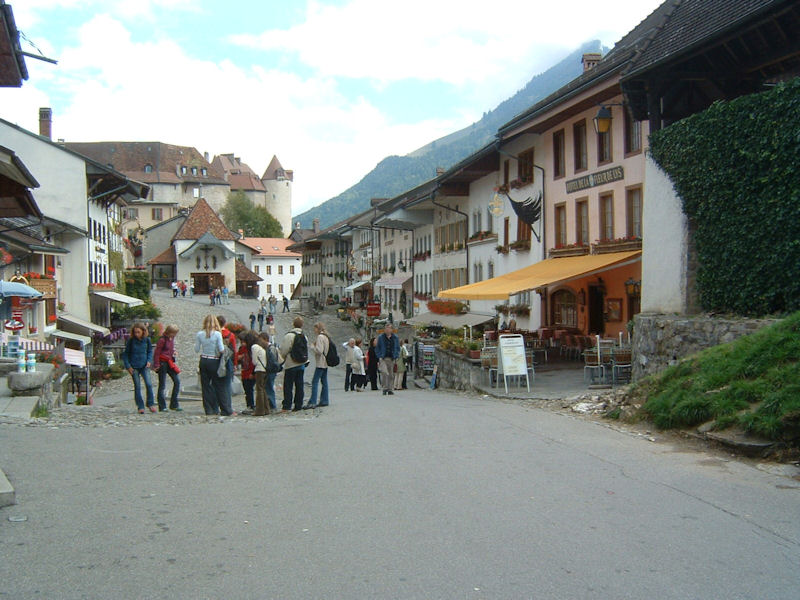
There's
the castle at the end of the single hilltop village street, just ahead of us --
actually, TWO castles, first St. Germain and then Gruyères.
Gruyères,
originally a family-owned town and castle (with 19 counts from the 11th to the
16th centuries), claims some prominence in the great Swiss victories over Burgundy
in the 1470s. The castle served as administrative buildings for Fribourg from
1554 to 1849 and  was
then a private residence until the canton of Fribourg established the modern museum
in 1938. was
then a private residence until the canton of Fribourg established the modern museum
in 1938.
It
resides just south of Bulle at the edge of the Swiss Plateau of the cantons of
Vaud, Fribourg, and Berne, just where they meet the mountains of the Préalps.
(The Moleson, right,
at 2000m, hovers just 1200m above the village [stolen
picture].) The
mighty River Sarine flows out of the mountains just past the castle here and on
to the brand-new Lac de Gruyères, and eventually to the Rhine near Bâle
or Basel.
Traveling
from Gruyères back up the valley of the Sarine takes you past Montbovon,
Château d'Oex, then up into the heart of central Switzerland past Gstaad,
Zweisimmen, Spiez on the Lake of Thun, and then Interlaken as well, eventually
to the Lake of the Four Forest Cantons. Then Liechtenstein. Then Austria. The
Slovak Republic. Moldava, Belarus, etc.
| 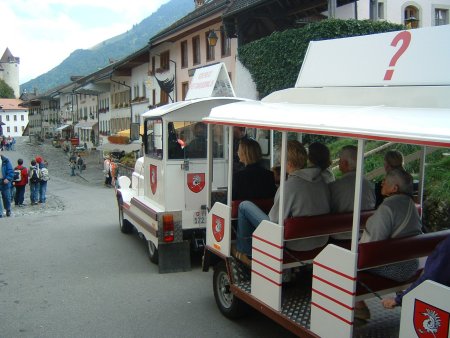
|
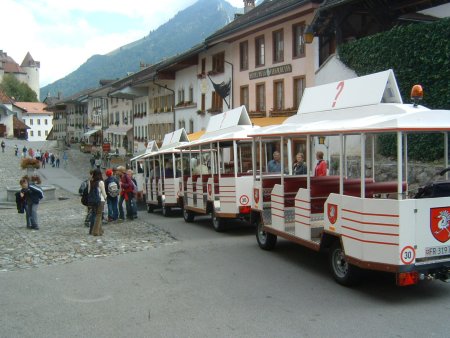
|
An
innovation since our last visit -- A TRAIN so you
don't have to walk all about to see the sights! Splendid! The village is only
one street about 150 meters long, but this cool train will save you the effort
of walking back and forth along it AND take you down
to, and back up again from, the cheese factory/museum in Pringy at the bottom
of the hill.
The
cheese factory near the rail station, which was extremely interesting but hell
on the nose in the old days, has in recent years been renovated into a very modern
and somewhat less offensive cheese experience, instructive and, if you don't harm
yourself by pigging out, well worth the time.

Schoolkids
counting their change, as they always do, borrowing from one another for a last
postcard and a specialty Gruyères meringue.
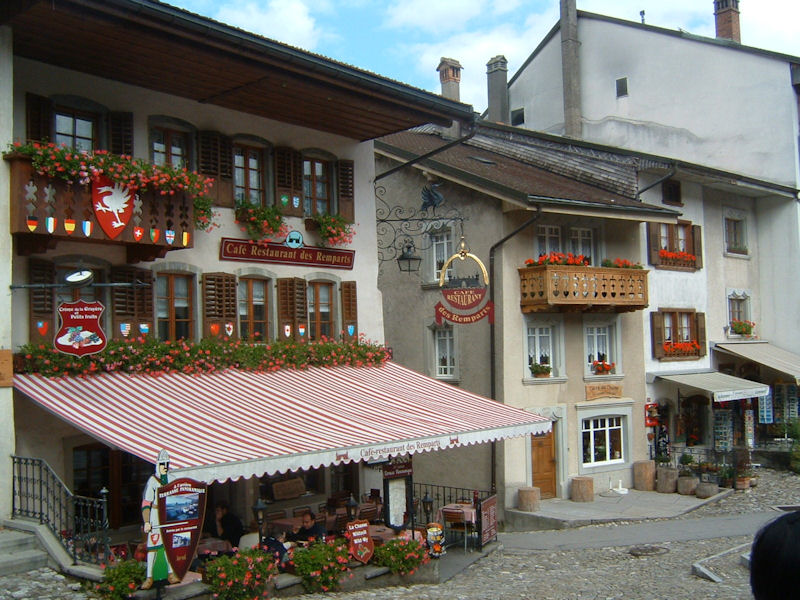
No want
of establishments here offering fondue, meringue, and strawberries with Gruyères
cream on top at prices that, elsewhere, might buy you a small automobile.
| The
white crane on red background in the banner above left is the emblem of the village
and the old dukedom -- the name Gruyères
is a variant of "grue" (the bird, the big hoisting machine, and a prostitute). |
Fans
of fondue may be interested
to learn that, whereas specialists would not normally be found in the same room
with a fondue that did not have four cheeses in it (for example, 1/3 Emmenthaler,
1/3 Gruyères -- both hard cheeses -- and 1/3 a combo of two soft cheeses,
such as Vacherin, Tilsiter, Appenzeller, etc.), real Fonduistas have frequently been seen grinning in the Gruyères train station in Pringy
(the buffet de la gâre) over a solo Gruyères fondue or a moitié-moitié,
half Gruyères and half anything else.
And
of course, as with any good fondue, the exquisite tastes are increased many-fold
if you've got to them by hiking rather than on a crowded tour-bus. Similarly,
the ponderous weight in your lower-middle is much increased if you're going back
home again with everyone else on the same crowded bus, perhaps with awkward noisy
accompaniment.
The
ramparts and gates at the northeastern side of the village street, with schoolkids
cavorting.
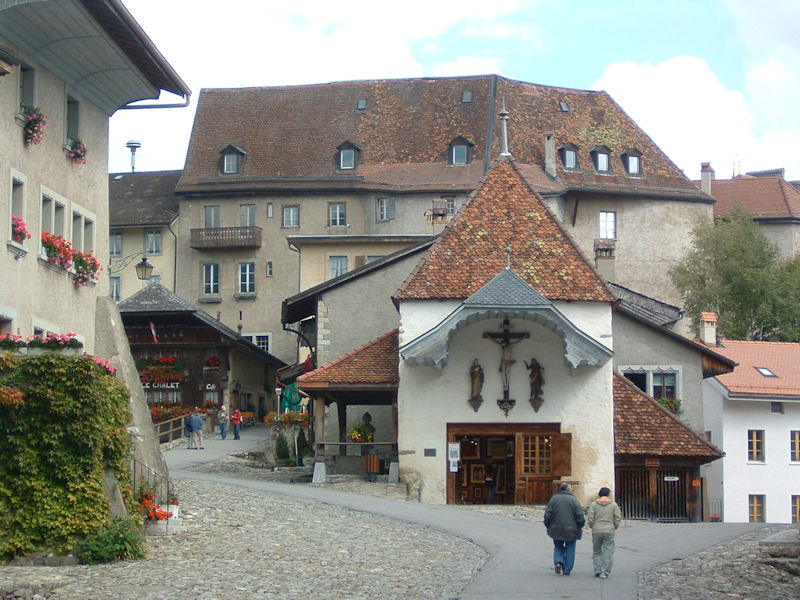
Proceeding
up the village street, with a venerable religious edifice (center) being put to
very good use as an art gallery. (In Gruyères, nearly everything not selling
postcards and cowbells seems to be either an art gallery or a fondue/meringue
gallery.)
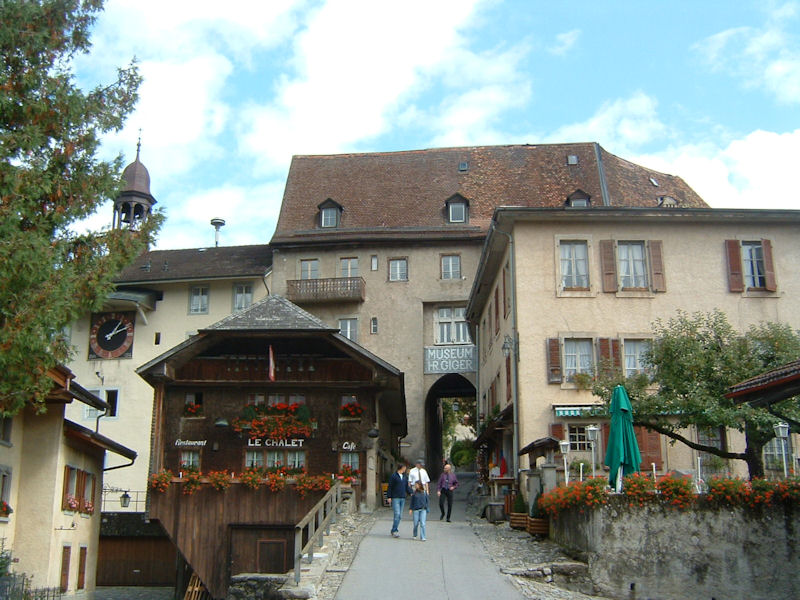
Trotting
briskly along towards the Château de Gruyères at the top end of the
village, we pass first through a gate in the Château St Germain, which now
boasts, since 1998, the museum of the freaky art of H. R. Giger. Mr Giger had
something to do with the Alien movies and specializes in fantasy-sci fi aliens
and furniture, and here he is in his glory, with many of his original works in
the museum on the right and, newly, a bar, with Alien furnishings, on the left
where a giftshop used to sell coffee mugs with the Swiss flags on and cowbells.
Left:
The tourist shop on the right specializes in miniature Swiss cowbells and the
restaurant on the left, in fondue, but once we pass under the arch we're in Giger
land. Right:
Part of the Giger gallery.
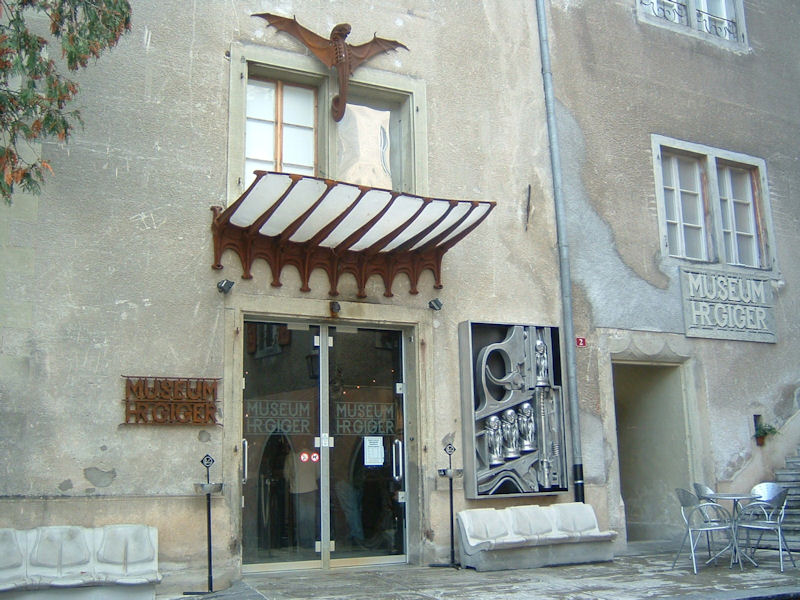
The entrance
to the H. R. Giger museum. Strange stuff: technically
very well drawn and crafted, imaginatively very freaky and creative, sometimes
thought-provoking in a way, and always nasty and off-putting. And definitely not
what we came here for.
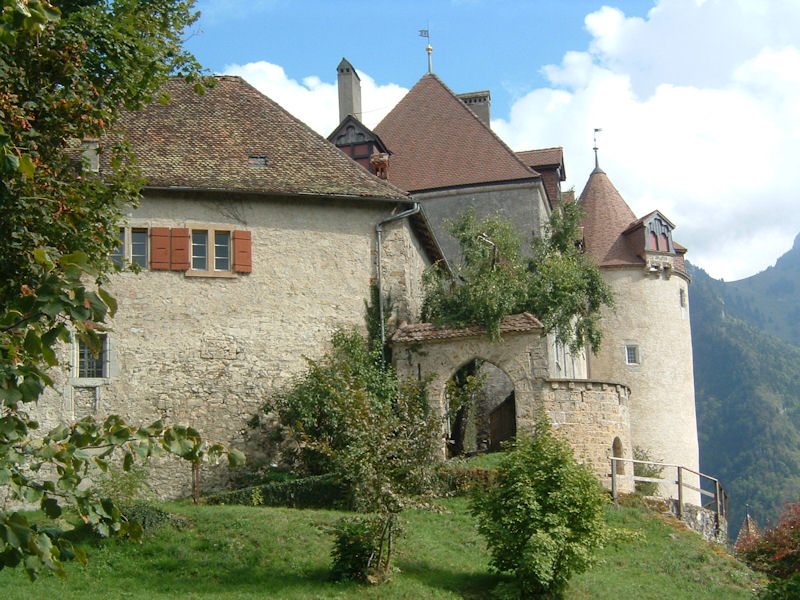
Here's
what we came here for: the great late-medieval pile of the Château de Gruyères.

Having
passed through St Germain at the top of the street, we venture now into the precincts
of the castle of Gruyères. Abandon all hope, ye
who enter here -- there's 4 dollar entry fee. Without it, you can only
stare at the outside brick work and perspire for the rest of the afternoon. So,
in October 2003, we'll dig deep and go on in. (As an Ami du Château, I get in free.)
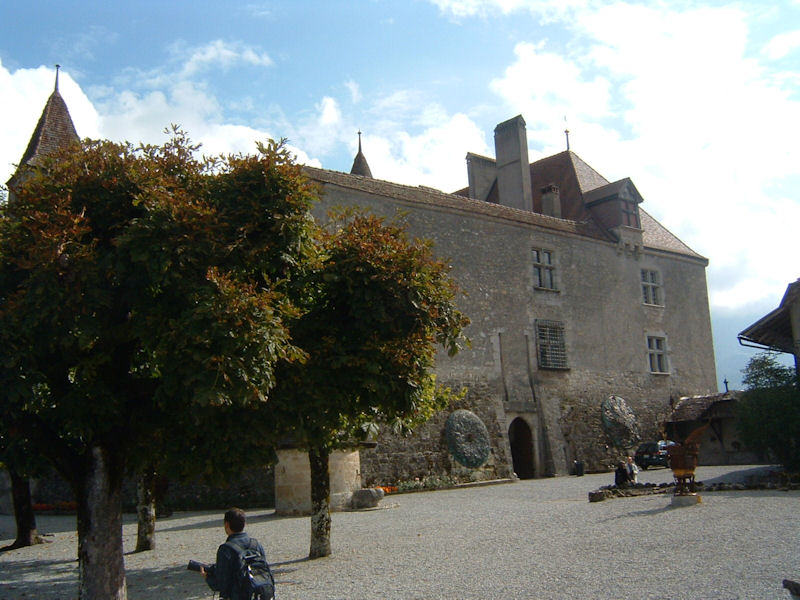
The castle
itself seen from the esplanade inside the gates. Not a very nice photo itself,
but it gives you a sense of the lay of the land.
More
of the esplanade in front of the castle, and the dinky little chapel.

Gazing
down from the esplanade at cute little Epagny 115m below.
Mr
Peck used to run frequently from Leysin
to Gruyères over the mountains and regularly shuffled through Epagny
after about five hours, bound for the castle looming above, drooling in a state
of delirium.

Passing
into the courtyard of the castle proper, we find a small but homey arrangement
of main buildings (left) and outer wall. Galleries in the main buildings have for years been hosting displays of fantasy art works, and newly a narrow tower in the outer wall on the
right has also been acrobatically converted into a four-story display constructed all up and down a spiral iron staircase up the center.
Great
fantasy art it is, too,
but the more fantastical because you need to hang half off a narrow spiral iron
staircase with white knuckles to see any of it.
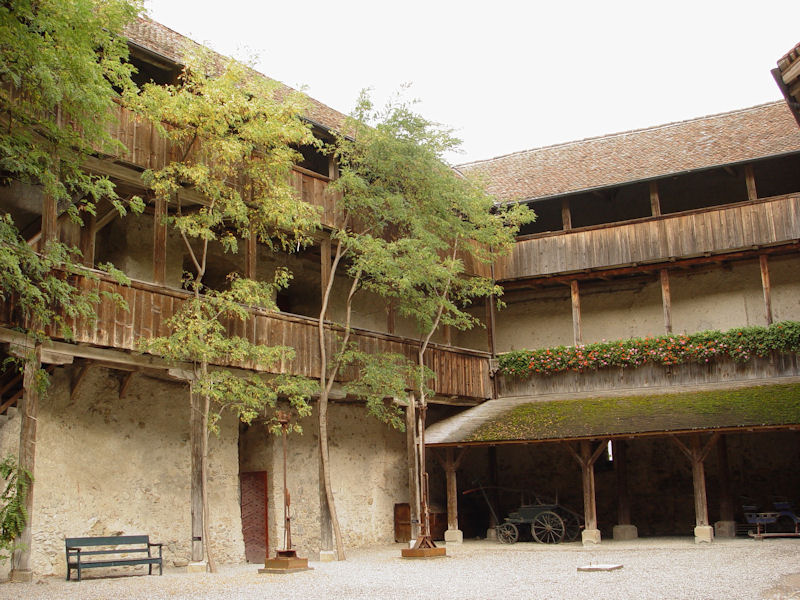
A warmer,
homier look to the inner courtyard than the photo above, because Alison's digital
camera cost about five hundred francs more than mine did.
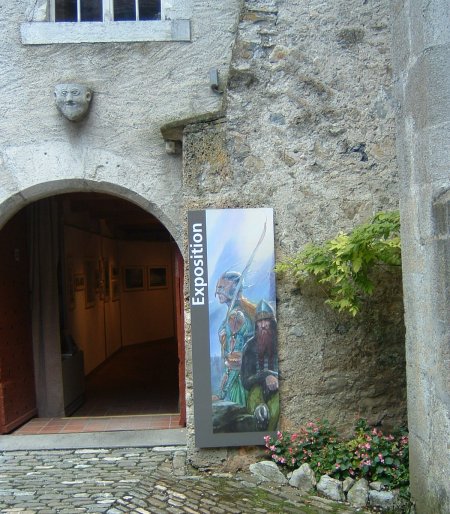
The exposition
in the main halls, October 2003 -- John Howe, a British artist living in the region
who has been doing scenes from Tolkien's Lord of the Rings for many years. Excellent draftsmanship and the rest depends upon how much you
like Tolkien. (But by the time you read this, the exhibition has already moved
on.)
And
here's a bit of the other exhibition, Patrick Woodroffe, all stretched down the
inside of four stories of the narrow tower (that's why all the angles are wrong
in the photos). Like them or not, these paintings
invite long scrutiny and reflection, and looking at them from an iron spiral staircase
in a narrow tower with tourists above and below you trying to get past you cannot do them even Guatánamo justice.
(A
few more here.)
Different
art -- late 18th century
scenes on the walls of the drawing rooms, executed by famous friends of the castle
owners at that time, the Bovy family. The kids' bedroom is even cuter (no photos
here), with happy little squirrels and songbirds all over the place.
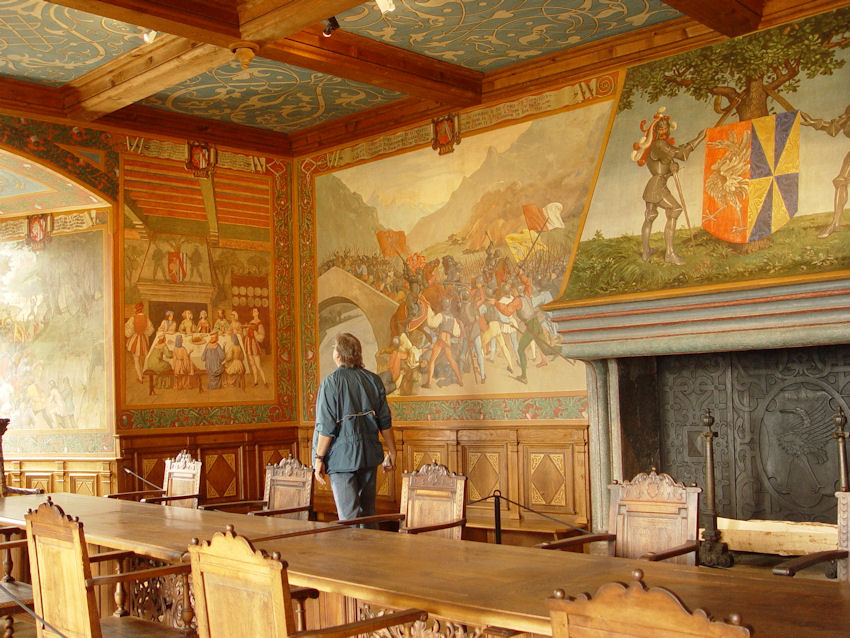
That's me in the great hall, somberly reviewing the history of the castle owners'
interactions with regional history in epic illustrations all around the room.
Not the greatest art, but there are hours of fun in picking out the strange little
details and trying to remember enough Latin to get a general sense of what's going
on.

The
gardens at the end of the castle, seen from the hall above.
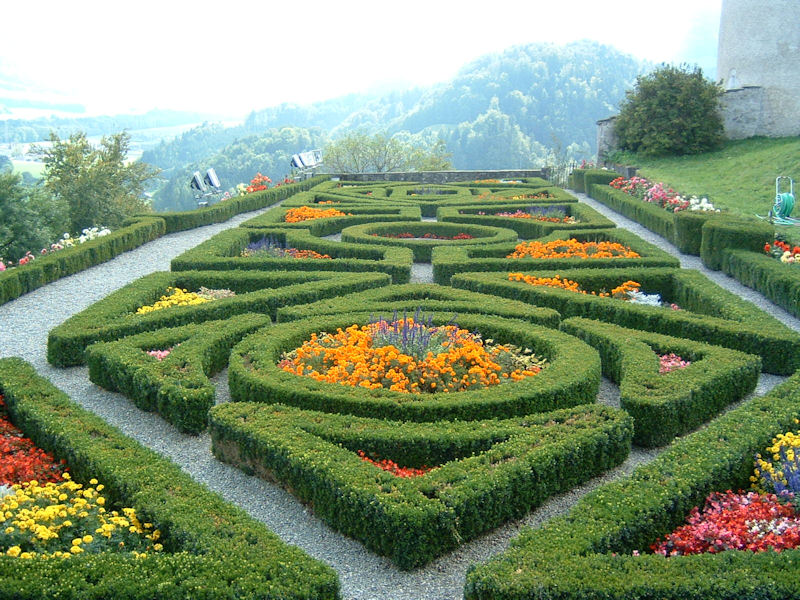
And
the same gardens, seen from the gardens.

Dr
Alison B. Peck, photographing flowers in the same gardens, the River Sarine in
the distance.
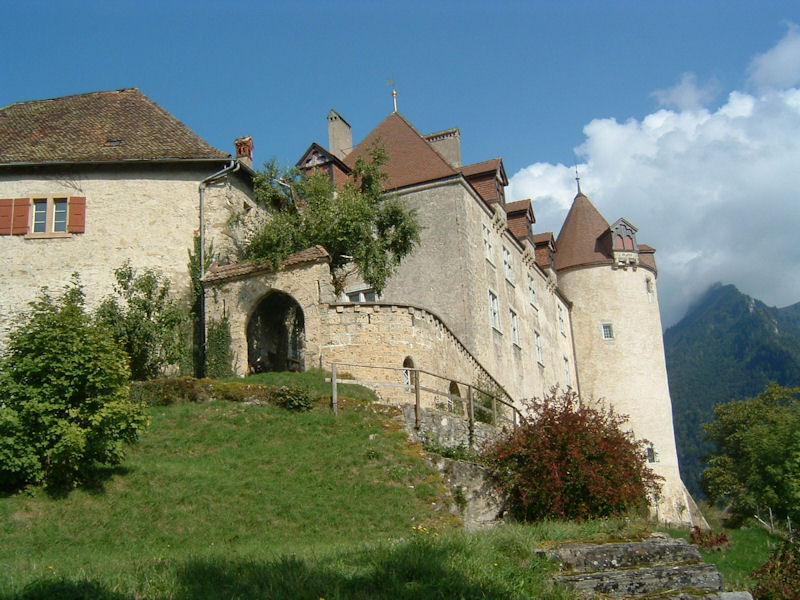
The south
façade of the main castle building, having just completed the scenic walk
around the perimeter at the base of the walls
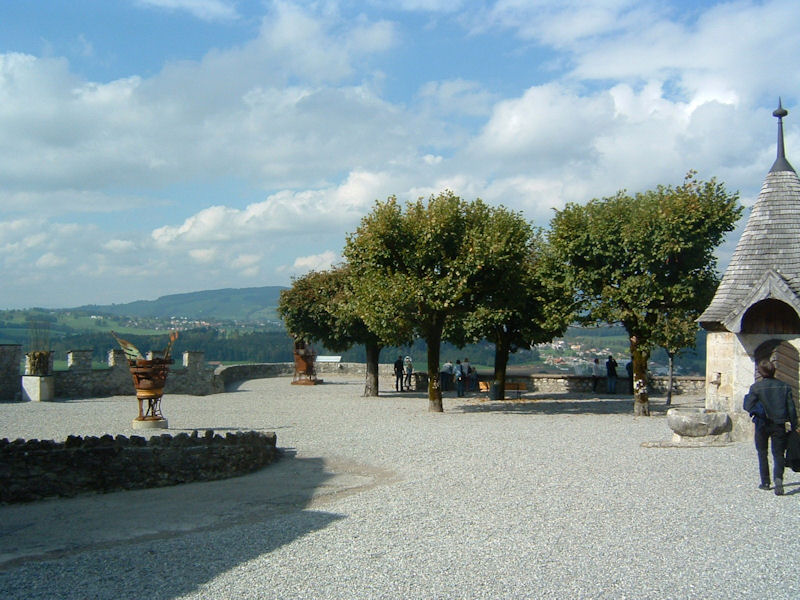
And back
up onto the castle esplanade, where six centuries ago the guardsmen kept fit by
battering one another with wooden staves and knights' horses pooped all over,
we see still more fantasy art, in this case freaky iron sculptures, many representing
implausible outer-space vehicles with a medieval theme.
Here
on the esplanade in October 2003, overlooking the Swiss plateau towards Bulle
and Fribourg and beyond, we find the narrator and daughter Alison (left), and
astrophysicist Satoki and Alison again.
| The
esplanade in earlier times

. .
. the narrator Dwight and daughter Alison some years ago in precisely the same
attitude and place, but without Satoki. . .
. . . and (left) Alison's mom and Alison herownself in 1977, and (right) former-roommate
Lowell, Charlie, Cathy, Sheila, and Alison, similarly in the same place, in about
1979.
And
here's Marlowe Peck on the same esplanade: left (foreground)
in 1985 with Jay, Zinnia, and Hannah; and right, at Christmas 2002, with Dima
|

Outer
walls at night, Christmas 2002

And now
back to 2003, we're leaving quaint Gruyères without having spent a dime
on meringues or solo-Gruyères fondues or strawberries and Gruyères
cream (just a 5 franc croque monsieur that took 15 minutes to get cooked up).
Gruyères
can be a very touristy place, in the right season, and there's a good reason for
that: it's a wonderful place to visit, except for
the tourists.
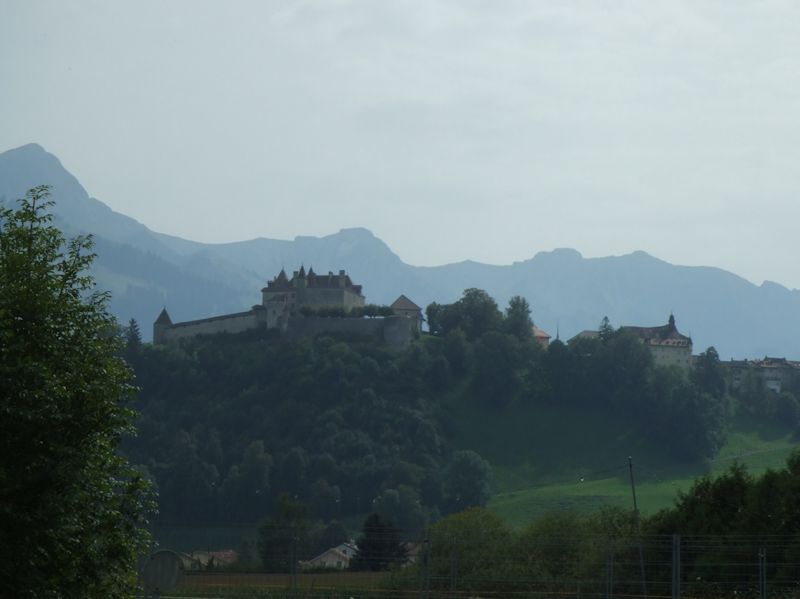
Just
passing through, driving towards the Pays d'en Haut, September 2006. This is from
the roadside on a grey day, coming from Bulle to the north. The castle looms on
the hill, and the walled village of Gruyères runs down towards the right.
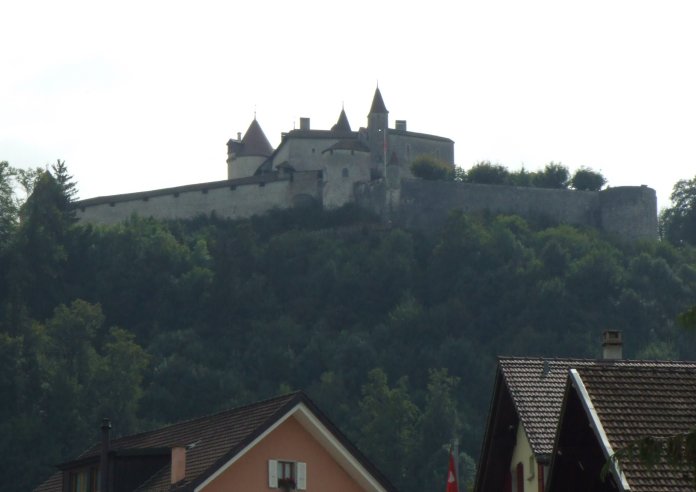
The
château overlooking the village of Epagny at the foot of the hill.
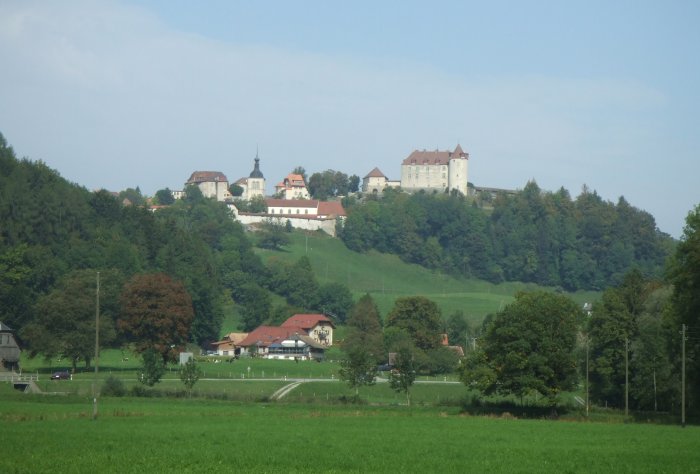
The
Château de Gruyères from the south, near Enney on the mighty river
La Sarine. The road across the lower part of the photo leads out of the Pays d'en
Haut (left), from Interlaken and the Lake of Thun past Zweisimmen, Gstaad, Château
d'Oex, and Montbovon to go out (on the right) onto the Swiss Plateau near Bulle
and Fribourg. The inhabitants of the valleys between here and Thun and Interlaken
have resolutely fought off all attempts to put a major motorway up the valleys.
So the traffic can be brutal on Sunday evenings in the ski season. But this is
25 September 2006, and there are no cars at all.
 Feedback
and suggestions are welcome if positive, resented if negative, Feedback
and suggestions are welcome if positive, resented if negative,  .
All rights reserved, all wrongs avenged. Posted 28 November 2003, revised 29 September 2014. .
All rights reserved, all wrongs avenged. Posted 28 November 2003, revised 29 September 2014.
|
 Dwight Peck's personal website
Dwight Peck's personal website

 was
then a private residence until the canton of Fribourg established the modern museum
in 1938.
was
then a private residence until the canton of Fribourg established the modern museum
in 1938. 








































